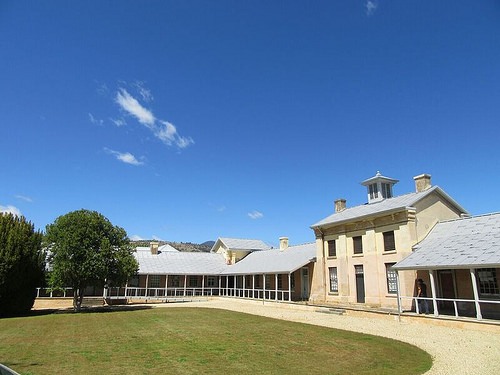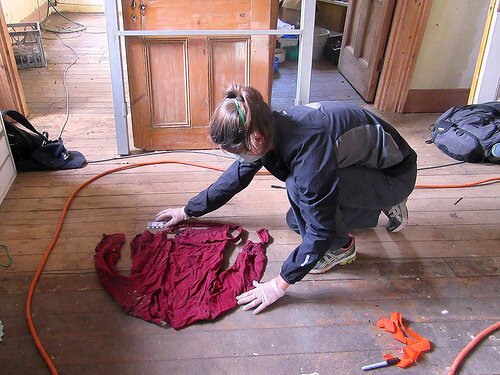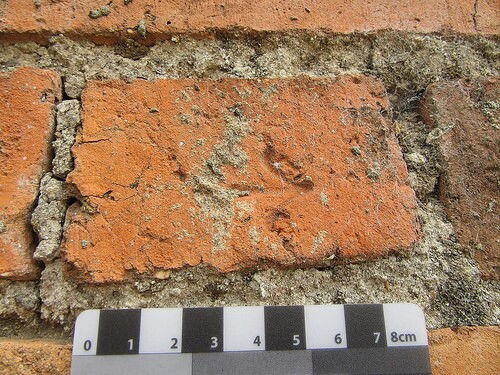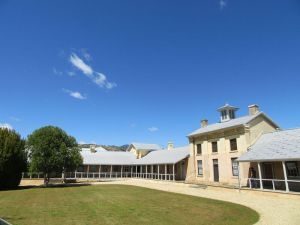
In February, it is the height of summer in New Norfolk, Tasmania. Although, at an average of 77 degrees Fahrenheit during the day, one can walk leisurely around without breaking a sweat in its characteristically cool temperate climate. Located in this Australian island state’s southeastern region, the town of over 5500 residents straddles both sides of the Derwent River, which runs through the valley by the same name. It is set within a backdrop of high hills dotted with gum trees. Walking along this river, one is likely to hear Kookaburras calling as they flutter from gum tree to gum tree, and at dusk or dawn, one might perhaps encounter an Eastern Grey Kangaroo.
The Asylum
Anciently, the banks of the Derwent around New Norfolk were covered by forests, and there is evidence of human habitation in the area — Australian Aboriginals — going back many thousands of years. But the town of New Norfolk was born in Australia’s colonial era, when groups of settlers, including convicts conscripted to do the hard work of building, arrived from the British Isles and other points in early colonial Australia beginning in the early 19th century. The town still features many of the structures and traces of that bygone era, including an almost forgotten complex known as Willow Court, a large group of buildings that served as a mental health institution from 1827 to 2000 and now under archaeological investigation by a team headed by Dr. Heather Burke of Flinders University. Originally named the New Norfolk Insane Asylum, it was built to care for the free people and convicts transported to Tasmania under the direction of the British government. Today its remains are only a decaying reminder of its past.
“Institutions like Willow Court are the physical remains of the forced labor economy that modern Australia emerged from,” said Kate Leonard, an archaeologist who helped to investigate the site remains. “Even the early structures of Willow Court, such as the Barracks Building, were built with convict labor. The evidence of this can be seen in the arrow-marked convict made bricks that are visible underneath the flaking plaster.”
Leonard came to New Norfolk for a few weeks as a volunteer to help with the investigations, which involved mapping the site’s features, conducting geophysical surveys, and cataloguing stored artifacts in anticipation of future excavations. It was part of an ambitious global project she hatched to volunteer her knowledge and skills to work at no less than 12 projects in 12 countries in 12 months. New Norfolk is the second stop on her Global Archaeology journey.
_____________________________________________
The barracked bulding of Williow Court as it appears today. Courtesy K. Leonard
___________________________________________________________
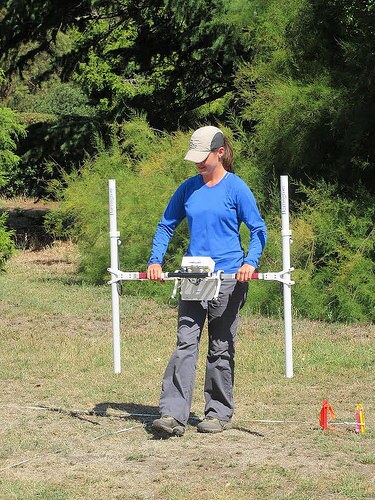
Kate Leonard doing a geophysical survey. Courtesy K. Leonard
________________________________________________
Kate Leonard busy with artifact cataloguing. Courtesy K. Leonard
__________________________________________________
A convict-made brick. Courtesy K. Leonard
___________________________________________________
The Legacy
Along the way at Willow Court, Leonard also encountered some tantalizing traces of history literally written on its walls.
“I had the opportunity to do a full survey of the graffiti that littered the inside and outside of the original Willow Court Barracks, whose construction was completed in 1834,” she said. “The graffiti was a mix of modern vandalism and the handiwork of inmates. I became absorbed with the search for the early writing on the walls and window sills, photographing it and making notes on location, condition and context. With my teammate I also continued to photograph the wall of the B Ward building (also known as Bronte).”
Her work in this area will result in a graffiti catalogue, something that the site investigators have long wanted to produce. The record could help shed some light on the unwritten history of inmate life.
Site investigators hope that the ongoing investigations will ultimately help paint a clearer picture of a sad, hard but important slice of life in this early colonial place. “Although I was aware of Australia’s Convict Era and had some general knowledge of the severity of the penal system in place, the mental health repercussions had never crossed my mind,” added Leonard. “The journey in convict ships, physical punishment and mental punishment (such as solitary and silent confinement of prisoners in places like Port Arthur and Cascades Female Factory), and forced hard labor tested the limits of all the convicts minds and some were irreparably damaged by their experiences.”
Leonard notes, however, that despite the hardships, “many of the convicts served their sentences and then moved forward with their lives as free citizens of the colony.”
“These men and women persevered through transportation, hard labor and foul, disease ridden, heavily over-populated prisons to become the foundation of modern Tasmania. The stories of those sent to Tasmania during the convict era are not easy to hear, but that is exactly why they should be told: they are a key part of what shaped Australia and its resilient people.”
Popular Archaeology will be following and reporting on Leonard’s worldwide experiences periodically throughout 2016 as she hops from one location to another.
Readers interested in reading about and supporting her self-directed Global Archaeology crowdfunded project can learn more at gofundme.com/globalarchaeology.
_____________________________________________

______________________________________________
Travel and learn with Far Horizons.
____________________________________________
This richly illustrated issue includes the following stories: Recent findings shedding new light on the whereabouts of the remains of Philip of Macedon, father of Alexander the Great; how an archaeologist-sculptor is bringing bones of the dead back to life; archaeologists uncovering town life at the dawn of civilization; an exclusive interview with internationally acclaimed archaeologist James M. Adovasio about what makes the Meadowcroft Rockshelter prominent in the ongoing search for the first Americans; what archaeologists are finding at the site of the ancient city of Gath, the home town of the biblical Philistine giant, Goliath; and how scientists are redrawing the picture of human evolution in Europe. Find it on Amazon.com.

